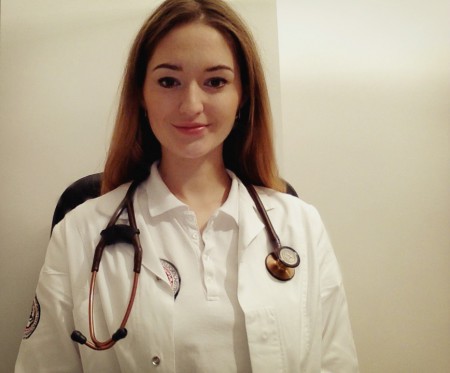
of General Medicine.
Photo: Archive of J. B.
Julia Bayer, a student of General Medicine, passed the practical subject K10: for ten days she shadowed a doctor she had chosen. Every day she wrote a blog the nine parts of which we will publish Mondays and Wednesdays. Illustrations by Adam Kalina.
10th Day: Ask the Right Question
 Today, I could see how important it is to ask the right questions and how some seemingly unimportant information may be critical for the diagnosis; a middle-aged dancer came in with some back pain and during the consultation it turned out that she tends to fall a lot without an obvious reason and even since childhood, and this raised the suspicion for Charcot-Marie-Tooth disease and thus an EMG was ordered.
Today, I could see how important it is to ask the right questions and how some seemingly unimportant information may be critical for the diagnosis; a middle-aged dancer came in with some back pain and during the consultation it turned out that she tends to fall a lot without an obvious reason and even since childhood, and this raised the suspicion for Charcot-Marie-Tooth disease and thus an EMG was ordered.
One patient brought forward an issue – namely that people may continue their jobs despite severe pain trying to hide it due to the fear of losing their job. This patient had severe knee pain and a physically challenging job, but was scared that she would not be hired again if she quit because of her age.
A young woman with back and leg pain came in. She used to suffer from anorexia nervosa in her teens and hence developed osteopenia which causes her pain. Nevertheless, rehabilitation is an additional way to help her.
Also, rehabilitation can be an important part of the therapy after surgery; for example, a baby underwent surgery for congenital talipes equinovarus and now receives physiotherapy and is regularly checked up in the pediatric rehabilitation department. He has made huge improvements since his last visit.
This brings me to the end of my diary which is, in fact, only an excerpt of some cases and does not go into great detail. It was a fun educative time, and I wish K10 was not a one-time only subject. A big thank you goes to Dr. Pešicová!
9th Day: A Walk Through a Forest
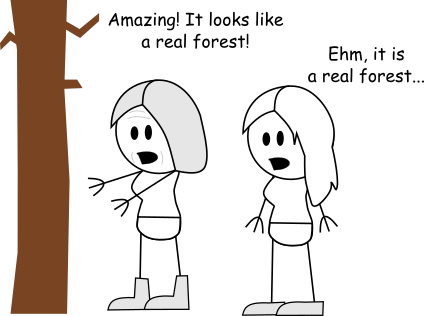 I spent most of the day in the sports medicine department with Dr. Slabý. First, I observed two stress tests. The first patient was a middle-aged woman with transposition of great vessels, soon to undergo surgery. Dr. Slabý showed me pictures of the surgeries performed in the past and explained the one used today. The other patient was in remission of Hodgkin’s disease since 2001. He has been going to regular check-ups to rule out recurrence, secondary malignancy, or endocrine abnormalities.
I spent most of the day in the sports medicine department with Dr. Slabý. First, I observed two stress tests. The first patient was a middle-aged woman with transposition of great vessels, soon to undergo surgery. Dr. Slabý showed me pictures of the surgeries performed in the past and explained the one used today. The other patient was in remission of Hodgkin’s disease since 2001. He has been going to regular check-ups to rule out recurrence, secondary malignancy, or endocrine abnormalities.
I also spent some time in the ‘Pohybové terapie’ room where a physiotherapist informed me about the different exercises they offer, such as bicycle ergometer and rowing, and for which patients and with which precautions.
Lastly, I went to watch one patient with knee pain use the ‘Reha Walk’ under supervision of a physiotherapist. It is basically a treadmill with some special functions and a screen connected to a computer, and the goal is to test the quality of stance and walking and improve both. First, the distribution of pressure of the foot soles is shown on the display in front of the treadmill. Gait & stance analyses are done followed by gait & virtual training. It was quite funny to watch because there is a screen that lets the patient walk through a forest. Thus, it resembles a video game with barriers to avoid or to hit to get points.
8th Day: Another Round with Professor Kolář
Today, I joined the ward round again with Dr. Kolář, seeing some familiar patients from the days before and their progress.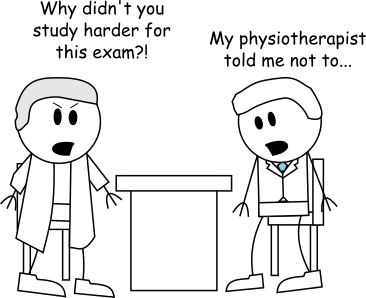 One patient with a patella fracture one year ago reduced her antidepressant medication stopping Zoloft because of adverse effects. This step probably contributed to her increased pain perception. As so many patients, she was very tense and was recommended some regular relaxation ritual such as warm baths, yoga, relaxing group, psychotherapy or the like.
One patient with a patella fracture one year ago reduced her antidepressant medication stopping Zoloft because of adverse effects. This step probably contributed to her increased pain perception. As so many patients, she was very tense and was recommended some regular relaxation ritual such as warm baths, yoga, relaxing group, psychotherapy or the like.
A woman suffered from epilepsy since a young age, and it turned out to be drug-resistant. After years of trying to find an effective drug combination, she developed quadruparesis causing her to be in a wheelchair for the past three years. The cause is still unknown. Needless to say, it is a very complex case which requires a lot of patience from all involved.
One Czech medical student was the last patient of the day presenting with back pain, most likely from studying too much.
7th Day: A National Holiday
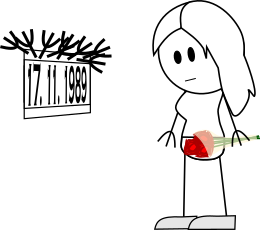 Tuesday was a national holiday – commemorating student demonstrations in 1939 and 1989.
Tuesday was a national holiday – commemorating student demonstrations in 1939 and 1989.
6th Day: Doctors – the Worst Patients
One patient with an endoprothesis for her radial head after a fall and fractures developed frozen shoulder syndrome as well as slight carpal tunnel syndrome. The doctor I was with that day let me examine the patient's scar, ROM, strength and reflexes. Also, she let me write the status praesens of several other patients with her supervision.
Very surprising was a woman with ALS who lives with the disease since 2004 which is much longer than the average prognosis. Due to her severe dysarthria, I could hardly understand anything without the help of her daughter who was accustomed to her speech.
 Less surprising was one patient who refused a medical student to be present at his examination; it happens rather seldomly but unfortunately occurs from time to time.
Less surprising was one patient who refused a medical student to be present at his examination; it happens rather seldomly but unfortunately occurs from time to time.
It is known that doctors can be the worst patients. The next patient is a good example; he was getting voltaren injections for his back pain several times a week despite his doctor's warning. Also, he uses a belt for his back for the whole day which is recommended for only a couple hours because of the risk of muscle wasting. I hope that I won't be the same kind of patient. Another doctor came in with pain in one foot after a fall; after two months there was still hypertonus and pain. She was recommended to do an X-ray several times, but it seemed like she was worried about the radiation although it would only involve such a small area.
5th Day – A Day Off
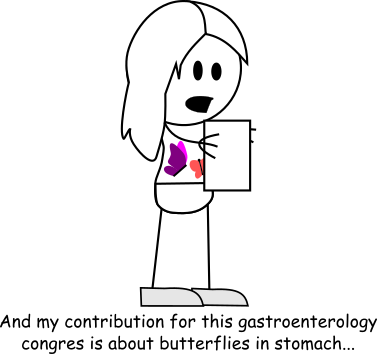 On Friday, I was not able to come to Motol because I had recently been invited to present my research project with IKEM at the ‘Czech and Slovak Gastroenterology Congress’ in Prague. The preparation was a lot of work but it was a great experience that was worth it.
On Friday, I was not able to come to Motol because I had recently been invited to present my research project with IKEM at the ‘Czech and Slovak Gastroenterology Congress’ in Prague. The preparation was a lot of work but it was a great experience that was worth it.
4th Day: One Should Not Ignore Pain for Too Long
On Thursday, there is always a meeting in the radiology department discussing some patients' X-rays or MRIs with one radiologist, which I think is good practice for us students.
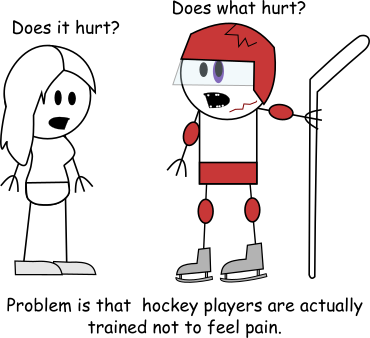 This day proved how wide the range of patients is in rehabilitation. One may not think of gastroenterology patients as requiring to rehabilitation, but a girl with GERD and the typical symptoms came in and Dr. Pešicová explained how improving trunk stability and doing exercises aimed at strengthening the diaphragm helps improve the LES tone.
This day proved how wide the range of patients is in rehabilitation. One may not think of gastroenterology patients as requiring to rehabilitation, but a girl with GERD and the typical symptoms came in and Dr. Pešicová explained how improving trunk stability and doing exercises aimed at strengthening the diaphragm helps improve the LES tone.
The most serious case of the day was a patient with a rare syndrome – oculocerebral renal dystrophy (Lowe syndrome); he is basically treated in almost every department. It is an XR disease which is why his mother has three healthy daughters. It was sad to see how she basically dedicated her life to caring for him all day seeming very tired but still not giving up the fight.
One former hockey player who didn't seem to be very sensitive concerning pain showed that one should not ignore pain for too long. After four years of back pain, it started to radiate into his legs, arms, and head which he could have prevented by going to a doctor earlier. Finally, he was so desperate that he even went to a Chinese alternative practitioner.
Lastly, I joined a physiotherapist whose patient had a large scar after emergent surgery for splenic rupture from trauma which was still active as well as one on his leg from a car accident, and his current shoulder pain may be connected with these. Once again, another interesting connection made by a physiotherapist.
3rd Day: A Ward Round with Professor Kolář
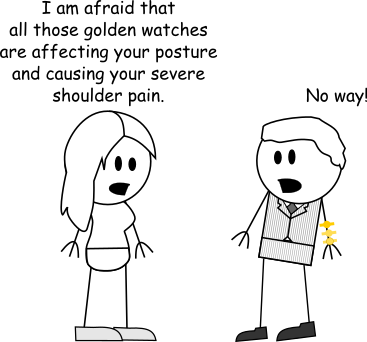 On Wednesday we went to the inpatient department for the ward round with Prof. Kolář. First, all the patients were discussed by the doctors, physiotherapists, logopedists, and ergotherapists. Subsequently, we went through the different rooms to see the patients. The conditions ranged from MS, stroke, disc herniations, arthroses, radiculopathies, encephalomyelitis to Charcot-Marie Tooth syndrome. Out of the 21 patients, two stuck out to me – one man with bilateral paresis of diaphragm without a known cause and one drug addict with Hepatitis C that contracted infective endocarditis which lead to an intracranial septic embolus causing her to develop quadruparesis.
On Wednesday we went to the inpatient department for the ward round with Prof. Kolář. First, all the patients were discussed by the doctors, physiotherapists, logopedists, and ergotherapists. Subsequently, we went through the different rooms to see the patients. The conditions ranged from MS, stroke, disc herniations, arthroses, radiculopathies, encephalomyelitis to Charcot-Marie Tooth syndrome. Out of the 21 patients, two stuck out to me – one man with bilateral paresis of diaphragm without a known cause and one drug addict with Hepatitis C that contracted infective endocarditis which lead to an intracranial septic embolus causing her to develop quadruparesis.
In the outpatient department, there were once again two very different patients – one lawyer with shoulder pain who refuses to pay attention to posture or do exercises and one patient with spinal muscle atrophy ending up in a wheelchair, but thanks to his cooperation being able to walk some distances, have a normal job, and living by himself in an adjusted flat without barriers.
Before the next patient arrived, we looked at the X-ray of hers – a young girl with knee pain – which showed that the patella was too high. After the examination, it was obvious that she had poor posture which overworked her quadriceps femoris making it tense and hence pulling her patella up. Dr. Pešicová prescribed orthopedic insoles and applied a kinesio tape which I know all too well since I used to roll my ankle a lot.
2nd Day: Everything Is Interconnected
The first patient in the morning was a great surprise to me when the physiotherapist offered a digital rectal exam … The patient was a lady with incontinence and lower back pain. She went through different exercises, including DNS, and since she was very perfectionist, the physiotherapist had to tell her over and over again that she should not be upset if the exercise did not go flawlessly, because it makes her tense and hence is counterproductive. The physiotherapist had the suspicion that her problems are connected to tense pelvic floor muscles, so that’s why she offered her a DRE for next time to assess whether it is in fact the case and if so to treat it at the same time. I did not know that physiotherapist also perform this procedure. It is cool to see how everything is so interconnected; I remember one physiotherapist found that my jaw hurt (although I was only aware of cracking sounds until then), and connected my back pain to my jaw and treated both.
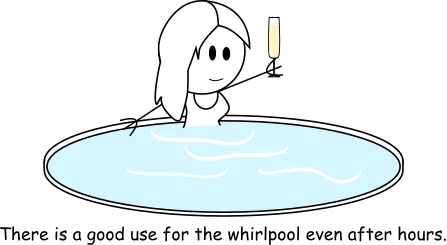 Since the rehabilitation department offers many different therapies, Dr. Pešicová wanted me to become acquainted with all of them – namely: magnetotherapy, water therapy, electrotherapy, ultrasound therapy, laser therapy, lymph drainage, and shock wave therapy; I got the latter on my ankle in the past and it was terribly painful. Anyway, I did not know we had a pool and whirlpools inside of the hospital.
Since the rehabilitation department offers many different therapies, Dr. Pešicová wanted me to become acquainted with all of them – namely: magnetotherapy, water therapy, electrotherapy, ultrasound therapy, laser therapy, lymph drainage, and shock wave therapy; I got the latter on my ankle in the past and it was terribly painful. Anyway, I did not know we had a pool and whirlpools inside of the hospital.
Sometimes rehabilitation can prevent a surgery. For instance, a man with a disc herniation was initially supposed to undergo surgery, but he was lucky to be seen by Prof. Kolář who prevented it. Usually it is difficult to get an appointment with him unless you’re a famous athlete, or some kind of VIP. The patient used to drive to the faculty hospital from another city, but obviously it is counterproductive to do physiotherapy and then loose the positive effect by driving three hours. Now he was instead admitted to the inpatient department for two weeks.
For the next two patients, Dr. Pešicová performed acupuncture to release the tension in their back. One of them had a periradicular injection done outside of Motol that was complicated causing neuropathic pain. It was obvious how much she valued Dr. Pešicová's expertise; it was nice to see how thankful some patients are.
1st Day: What My Doctor Will Be Like?
On the way to the hospital, I was curious about what my doctor would be like. Would I be welcome to ask questions? Or would I be considered a burden? And I must say, I was very lucky to be assigned to Dr. Pešicová whose English was very good, and above all she was friendly and willing to explain anything. Although I understand a lot of Czech, she always gave me a summary of each patient after they left.
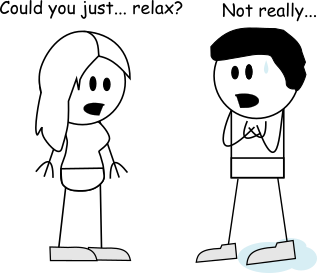 The rehabilitation department is made up of a spinal cord unit, inpatient clinic as well as adult and pediatric outpatient clinics. The first patient in the outpatient clinic was an older man who just wanted a renewed confirmation for his partial disability pension; obviously doctors do not like when you only ask for some paper, so Dr. Pešicová just focused on his medical condition. He was hit by a bus which caused him to develop compartment syndrome. I knew of compartment syndrome from some co-athletes who developed it from years of intense running. So it was interesting to hear about the acute version that has to be treated immediately by fasciotomy. Unfortunately, his surgery was complicated by a Staph infection, so he ended up having four surgeries.
The rehabilitation department is made up of a spinal cord unit, inpatient clinic as well as adult and pediatric outpatient clinics. The first patient in the outpatient clinic was an older man who just wanted a renewed confirmation for his partial disability pension; obviously doctors do not like when you only ask for some paper, so Dr. Pešicová just focused on his medical condition. He was hit by a bus which caused him to develop compartment syndrome. I knew of compartment syndrome from some co-athletes who developed it from years of intense running. So it was interesting to hear about the acute version that has to be treated immediately by fasciotomy. Unfortunately, his surgery was complicated by a Staph infection, so he ended up having four surgeries.
With the next patient I was re-introduced into Vojta's Therapy which is also famous in Germany. Since we had reha last year, I already had an idea about the technique which involves pressure stimulation points. Nevertheless, it was interesting to see it again, especially because this patient was very sensitive to this technique causing her to move involuntarily.
Also, I joined a physiotherapist whose patient had multiple sclerosis and received the well-known DNS (dynamic neuromuscular stabilization) therapy according to Kolář. The whole department has posters about this method which basically aims to restore dysfunction of the locomotor system.
The next two patients were quite opposite; one – a young man being very noncompliant and not doing the exercises told to do, and the other – an old lady taking the exercises very seriously. Both, however, had arthrosis and one thing in common which most people coming to rehabilitation seem to have – being tense and not being able to relax.
How It All Began
When I found out that we would have a subject where we can shadow a doctor in any department we choose, I started thinking about what I would be most interested in. My first internship was in cardiothoracic surgery when I was 13 years old, which fascinated me so much that since then I wanted to become a doctor. I’ve also had internships in gynecology, pediatrics, gastroenterology, and internal medicine during my studies. However, I still have not decided completely on which specialty I want to focus on in the future. I want to gain an extensive insight on each area before I arrive at a final decision.
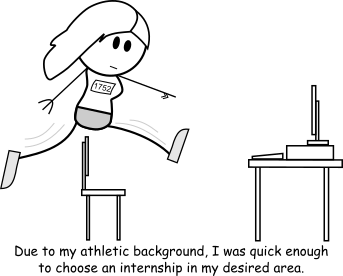 Due to my athletic background, sports medicine has always been a possible specialty, and since I hadn’t experienced an internship in this area, I chose ‘Rehabilitation and Sports Medicine’. From ages 13 to 23, I competed on the national level in track and field, so I was in contact with a lot of orthopedists and sports medicine doctors. I was training at the Olympic Base Camp in Stuttgart where we received free physiotherapy and massages a couple of times a week. It is amazing how physiotherapists can find areas of pain, and lessen the pain through myofascial trigger point therapy, mobilization or stabilizing exercises.
Due to my athletic background, sports medicine has always been a possible specialty, and since I hadn’t experienced an internship in this area, I chose ‘Rehabilitation and Sports Medicine’. From ages 13 to 23, I competed on the national level in track and field, so I was in contact with a lot of orthopedists and sports medicine doctors. I was training at the Olympic Base Camp in Stuttgart where we received free physiotherapy and massages a couple of times a week. It is amazing how physiotherapists can find areas of pain, and lessen the pain through myofascial trigger point therapy, mobilization or stabilizing exercises.
This internship brought back some old memories, and once again reaffirmed to me how much this multidisciplinary team can help patients and improve their quality of life. Also, it concerns a wide spectrum of patients – neurology, orthopedics, pulmonology, internal medicine, gastroenterology, and urogynecology – which will be obvious from my diary.
